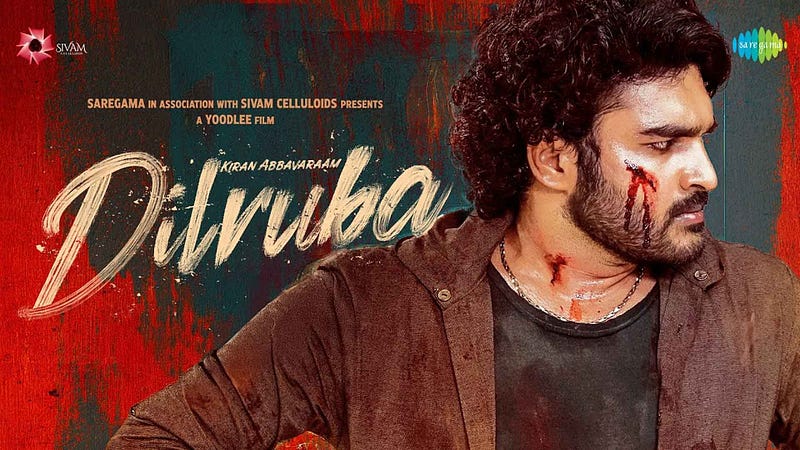Dilruba Movie Review: A Post-Blockbuster Thrill or a Missed Opportunity?
Introduction:
Dilruba Movie Review, the much-anticipated movie, promised a thrilling cinematic journey, leaving fans eager for an emotional rollercoaster. But did it truly deliver on its promise? With high expectations hanging in the air and limited screenings, I ventured into the theater to see whether this movie was worth the hype. What followed was a film that blended emotional highs and lows, complex relationships, and engaging action sequences, leaving me with both admiration and disappointment.

Dil Rubā: The Storyline
The film revolves around Siddhartha Reddy (played by Kiran Abbavaram), who finds himself struggling to move on after a breakup. In a bid to find a fresh start, he enrolls in a B.Tech college in Mangalore, where he meets Anjali (Rukshar Dhillon). Their relationship unfolds, shaped by the lingering memories of Siddhartha’s past. The ex (Divyansha Kaushik) is a significant character, who re-enters his life, creating emotional tension and drama.
However, the film does more than just focus on a simple love story — it’s about coming to terms with past mistakes and understanding the importance of words like “thank you” and “sorry” in personal growth. But does the movie bring this message home effectively? Let’s dive into the positives and negatives of Dil Rubā.
The Positives:
- Sam CS’s Background Score: Without a doubt, the score by Sam CS is a standout. Particularly during the pre-interval and interval sequences, the music creates an intense emotional atmosphere. The romantic and emotional scenes benefit from a score that truly elevates the mood, making it an unforgettable part of the experience.
- Action Sequences: The action in Dil Rubā is another high point. The choreography is sharp, especially in the extended action sequence from the pre-interval to the interval. This segment shows the film’s potential to combine emotion and physicality, and it continues with some impactful scenes in the second half.
- Dialogues and Themes: The film’s dialogue is well-crafted, mature, and meaningful. Its central theme about personal growth and the power of forgiveness is well-executed, even if it occasionally gets overshadowed by other aspects of the story.
- Cinematography: Visually, the film does justice to its natural locations. The realistic portrayal of Mangalore’s scenery enhances the film’s authenticity. The use of camera angles during the action sequences is particularly well done.
The Negatives:
- Weak Writing and Screenplay: The film falters when it comes to its storyline. It starts with the breakup of Siddhartha and then quickly shifts to a college setting where he saves Anjali. The plot feels formulaic and predictable. There’s an attempt to explore deeper emotions, but the connection between the characters and their actions feels underdeveloped.
- Uninspiring Love Track: Despite the chemistry between the lead actors, the romantic arc is rather uninspiring. The love story feels forced and lacks the emotional depth needed to engage the audience fully. Furthermore, the comedic moments involving Satya are awkward, taking away from the narrative flow.
- The Villain Track: A late introduction of a villain feels completely out of place. Instead of strengthening the emotional aspects of the film, the forced villain subplot detracts from the central love story. This shift disrupts the movie’s pacing and weakens its emotional core.
- Abrupt Action Sequences: While the action scenes are well choreographed, the build-up to these sequences often feels rushed. The abrupt cuts in certain scenes, particularly in the first half, create a disjointed experience that leaves viewers scratching their heads.
- Underdeveloped Characters: Siddhartha’s anger and Anjali’s character arc feel underexplored. There’s little explanation for the hero’s emotional volatility, and the heroine’s character changes drastically without clear reasoning, leaving the audience disconnected from the journey.
The Performances:
- Kiran Abbavaram delivers a decent performance, but his portrayal of anger could benefit from better voice modulation, especially during intense scenes.
- Rukshar Dhillon shines in the first half as a lively character but loses depth as her role becomes less engaging in the second half.
- Divyansha Kaushik brings emotion to her role as the ex, performing well in the more heartfelt moments.
Technical Aspects:
- Cinematography and Music: As mentioned earlier, the cinematography and background score are strong points, elevating the emotional weight of key moments.
- Dubbing and Sound: The film suffers from dubbing issues, particularly in the mismatch between lip sync and voiceovers, which can be distracting. While the sound mixing during the action sequences is effective, there are inconsistencies throughout, making some scenes feel less immersive.
- Editing and Pacing: There are some notable issues with the film’s editing, which leads to uneven pacing. Some scenes feel unnecessarily dragged out, while others are cut abruptly, leaving a jarring experience.
Final Thoughts:
Dil Rubā is a film that had immense potential, but it ultimately doesn’t fully capitalize on its strengths. While the action, music, and cinematography offer moments of brilliance, the weak writing, forced subplots, and underdeveloped characters hold it back from reaching its full potential. The film’s emotional core is present, but it’s lost in a sea of inconsistencies. For those looking for a complex and emotionally charged film, Dil Rubā may still resonate, but it falls short of being the thrill ride it promised.



Comments
Post a Comment